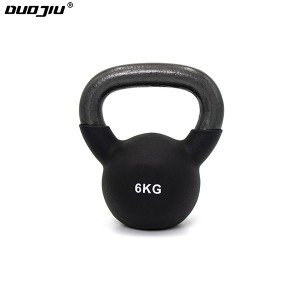Not surprisingly, kettlebell training has grown in popularity over the years.
Whether you're training at the gym or at home, you can build your entire workout around this multifunctional device.
But which style suits your training needs?
With so many options, buying the right kettlebell for your gym or home gym can be a hassle. That's why we've created a Kettlebell Buying Guide to help you make an informed decision before you buy.
This guide will give you an overview of the different options to consider when buying a gym or home use:
- Cast iron kettlebell
- Rubber chrome handle kettlebell
- Polyurethane kettlebell
- Competitive kettlebell
- Cast iron kettlebell
Cast iron kettlebell
Cast iron kettlebells are considered the most "classic" style in the industry. This is because they are usually molded from a single piece of metal. Therefore, cast iron kettlebells are affordable and good value for money.
When buying a cast iron model, it is worth checking that it is molded from a single piece of metal. Cheaper versions tend to weld the handle to the body of the bell, which greatly reduces the level of use the bell can withstand.
In addition, the low price makes them popular to buy as packaging. This includes a series of weights to help you with your training.
The downside of cast iron is that they can be noisy because they have no protective layer. This is especially true when using them in group lessons where multiple people put them down at the same time.
Main point: If you want to purchase weights of various weights at an affordable price, then these kettlebells are perfect.

Rubber chrome handle kettlebell
The chrome handles on rubber-coated kettlebells are particularly stylish and very popular in modern gym Settings. A chrome-plated finish ensures a perfectly smooth handle, providing a comfortable grip. This also makes them very easy to clean.
But those training under heavier weights often find the smooth chrome surface harder to grip than the rough texture of cast iron or competing models. This can cause the user to be unable to perform repetitive actions to the best of their ability due to hand slippage.
Main point: Rubber-coated models are your ideal choice if you like the comfortable grip of a modern design.
Polyurethane kettlebell
For kettlebell enthusiasts looking to invest in quality, polyurethane-coated kettlebells may be the best choice.
The layer around the core is sturdy and incredibly shock-absorbing. This is very useful for the kettlebell itself as well as the floor. Urane is often the standard choice for high-intensity fitness facilities. It keeps it fresh, rather than showing wear and tear like many cheaper styles.
The main takeaway: If you are looking for durability, a polyurethane coated model is the best choice.
Competitive kettlebell
Competitive kettlebells are unique in that they are standard size and shape regardless of weight. The reason for this is to allow athletes to:
It has no advantage over its competitors.
You don't have to adjust your technique when you add weight.
This consistency of size is achieved by hollowing out the center of the lightest kettlebell. This keeps the distance between the base and the handle the same.
Away from competitive weightlifters, this model is a good choice for users who have developed good techniques. The wide base is also perfect for floor exercises. However, because their handle shape is narrower than non-competitive bells, they are not the best model for two-handed practice.
Competition styles made of steel are often referred to as "professional" quality. Our original competitive kettlebells are coated with ethyl carbamate and therefore also have the benefits of ethyl carbamate kettlebells.
Main point: If you are training for a more technical move such as snatch, choose a range of races.
Post time: May-15-2023